Persons using assistive technology might not be able to fully access information in this file. For assistance, please send e-mail to: mmwrq@cdc.gov. Type 508 Accommodation and the title of the report in the subject line of e-mail.
QuickStats: Percentage of Adults Aged ≥65 Years Who Have Lost All Their Natural Teeth,* by Poverty Status† --- National Health Interview Survey, United States, 1998--2009§

* Based on response to the question, "Have you lost all of your upper and lower natural (permanent) teeth?" In 1998, separate questions were asked about upper and lower tooth loss.
† Poverty status is based on family income and family size using the U.S. Census Bureau poverty thresholds. Family income was imputed when information was missing, using multiple imputation methodology.
§ Estimates are age adjusted using the projected 2000 U.S. population as the standard population and three age groups: 65--74 years, 75--84 years, and ≥85 years. Estimates are based on household interviews of a sample of the civilian, noninstitutionalized U.S. adult population and are presented as 3-year annual averages to increase reliability.
During 1998--2009, the percentage of older adults who had no natural teeth was higher among those in families with low income than in families with higher income. Among all income groups, the prevalence of no natural teeth was lower during 2007--2009 (25.3%) than during 1998--2000 (31.0%).
Source: CDC. National Health Interview Survey, 1998--2009. Available at http://www.cdc.gov/nchs/nhis.htm.
Alternate Text: The figure above shows the percentage of adults aged ≥65 years, who have lost all their natural teeth, by poverty status in the United States during 1998-2009. During 1998-2009, the percentage of older adults who had no natural teeth was higher among those in families with low income than in families with higher income. Among all income groups, the prevalence of no natural teeth was lower during 2007-2009 (25.3%) than during 1998-2000 (31.0%).
Use of trade names and commercial sources is for identification only and does not imply endorsement by the U.S. Department of
Health and Human Services.
References to non-CDC sites on the Internet are
provided as a service to MMWR readers and do not constitute or imply
endorsement of these organizations or their programs by CDC or the U.S.
Department of Health and Human Services. CDC is not responsible for the content
of pages found at these sites. URL addresses listed in MMWR were current as of
the date of publication.
All MMWR HTML versions of articles are electronic conversions from typeset documents.
This conversion might result in character translation or format errors in the HTML version.
Users are referred to the electronic PDF version (http://www.cdc.gov/mmwr)
and/or the original MMWR paper copy for printable versions of official text, figures, and tables.
An original paper copy of this issue can be obtained from the Superintendent of Documents, U.S.
Government Printing Office (GPO), Washington, DC 20402-9371;
telephone: (202) 512-1800. Contact GPO for current prices.
**Questions or messages regarding errors in formatting should be addressed to
mmwrq@cdc.gov.
 ShareCompartir
ShareCompartir


